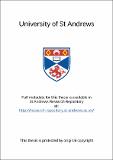Files in this item
The oxidation of chiral 2-thiazolines and thiazolidine-2-thiones
Item metadata
| dc.contributor.advisor | Aitken, R. Alan (Robert Alan) | en |
| dc.contributor.author | Armstrong, David Philip | en |
| dc.coverage.spatial | 255 p. | en |
| dc.date.accessioned | 2021-04-08T09:04:22Z | |
| dc.date.available | 2021-04-08T09:04:22Z | |
| dc.date.issued | 1991 | |
| dc.identifier.uri | https://hdl.handle.net/10023/22028 | |
| dc.description.abstract | Chiral 2-thiazolines with a variety of substituents at the 2- and 4-positions have been prepared starting from readily available enantiomerically pure aminoalcohols via intermediate 2-oxazolines or N-acylamino alcohols. The behaviour of these 2-thiazolines towards oxidation has been investigated in detail. Stable 2-thiazoline N-oxides, a previously unknown class of compounds, are formed with two oxidising agents: peroxytrifluoroacetic acid and dinitrogen tetroxide. A large number of other oxidising agents give mixtures of some or all of 2-thiazoline S,S-dioxides, aromatised thiazoles and both N-acylaminodisulphides and sulphonic acids apparently derived from initial hydrolytic ring-opening to the N-acylaminothiols followed by further oxidation. Conditions have not yet been developed to obtain the desired S,S-dioxides in pure form. Potential applications of the 2-thiazoline N-oxides in asymmetric synthesis have been investigated. The compounds surprisingly do not undergo 1,3-dipolar cycloaddition with a wide variety of dipolarophiles. They do however transfer oxygen both to neutral acceptors such as styrene and to organolithium species such as LDA and phenyllithium. Other anions have given disappointing results but the use of the N-oxides as a chiral OH⁺ source merits further investigation. A number of chiral thiazolidine-2-thiones have also been prepared from chiral aminoalcohols. Conditions have been developed for the efficient direct oxidation of these to the corresponding thiazolidin-2-one S,S-dioxides. A preliminary study of the thermal decomposition of one example showed this to proceed by a concerted fragmentation to give SO₂, an alkene and an isocyanate. This may be due in part to the bulky groups present at positions 3 and 4, and the prospects for elimination of only SO₂ to give β-lactams in cases with less bulky or interconnected groups look bright. | en |
| dc.language.iso | en | en |
| dc.publisher | University of St Andrews | en |
| dc.subject.lcc | QD400.3T5A8 | |
| dc.subject.lcsh | Heterocyclic compounds | en |
| dc.subject.lcsh | Heterocyclic chemistry | en |
| dc.title | The oxidation of chiral 2-thiazolines and thiazolidine-2-thiones | en |
| dc.type | Thesis | en |
| dc.type.qualificationlevel | Doctoral | en |
| dc.type.qualificationname | PhD Doctor of Philosopy | en |
| dc.publisher.institution | The University of St Andrews | en |
This item appears in the following Collection(s)
Items in the St Andrews Research Repository are protected by copyright, with all rights reserved, unless otherwise indicated.

